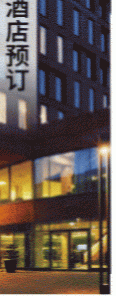|
  
- 积分
- 26138
- 威望
- 3588
- 金钱
- 16
- 阅读权限
- 110
- 来自
- 维藤(Witten)
- 在线时间
- 3187 小时
|
10#
 发表于 2007-4-1 09:18
发表于 2007-4-1 09:18
| 只看该作者

“You could say we overbuilt,” said Xiwai’s co-founder, Xu Ziwang. Boyish in his khakis and navy blazer, Xu, who is 50, has energy to match the wealth he earned as one of Goldman Sachs’s first mainland Chinese partners. He has devoted both his zeal and money to establishing the school with Lin Min, Xiwai’s headmaster, plowing proceeds from local real estate development into the enterprise. Theirs is a project with roots in a past that could hardly have seemed more remote on the balmy fall day the two of them proudly showed me around the one-year-old campus. Friends from their teenage years on a farm during the Cultural Revolution, Xu and Lin were sent from school to the countryside when they were about the age of the oldest Xiwai students who greeted us cheerfully on the paved pathways. The two men were among the many millions who, feverishly studying when they weren’t busy at their appointed labors, swarmed to take the college-entrance exam in the first sittings in 1977 and 1978; they ended up among the few who scored high enough to secure a scarce college spot. Thirty years later, both had studied and worked abroad (Xu in the United States, Lin in Slovenia, England and New Zealand), and back home, Xu had played a big role in privatization deals. Here they stood on what had been mud, eagerly sharing their vision of a pedagogical and curricular renaissance that would produce a generation “better than us.”
What a fortunate cohort today’s kids were, both men said: young people growing up in a booming country that had plenty of problems but also a growing middle class and expanding horizons. By 2006, China had vastly exceeded its higher-education enrollment goal; 22 percent of the college-age population — compared with roughly 40 percent of 18- to 24-year-olds in the United States — were receiving some form of postsecondary schooling. Yet Xu and Lin also joined in the widespread worry that Chinese youths, spared the real-life challenges their elders were forced to cope with, faced very different constraints. Hunkered down, doing endless exam-haunted schoolwork, they were constantly hovered over by their parents. In 1998, years before the McKinsey report of a talent shortage, Xu heard the wake-up call when he initiated Chinese recruiting for Goldman Sachs.
He picked three graduates from China’s top universities and was impressed that they all scored 100 percent on the exam following the associate training stint in New York — only to be disappointed a year later, when their performance reviews were in the bottom quartiles. “There’s a price,” he concluded, “for 12 years of prep for an exam, and that’s to always think there’s a narrow, right answer. If you give precise instructions, they do well. If you define a task broadly, they get lost and ask for help.” If he and Lin had their way, independent students eager to use their imaginations would be the dominant breed on their campus. They were counting on a rising tide of “broad-minded” parents eager to provide their children with the less-straitjacketed education — a creative mix of the best of East and West — that Xiwai preached and aimed to find teachers able to impart. But as we toured a campus plastered with exhortations to be “global citizens” and to “Smile, Embrace, Communicate, Cooperate, Negotiate,” Xu was also blunt: there are lots of obstacles, not the least of them the gaokao that exerts such sway. “The dilemma is, everybody realized it is the problem, but nobody knows what to do.”
Chinese routinely say they wish the exam weren’t such a monolithic force, and various provinces have lately been allowed to offer their own versions. Yet bigger changes — like Fudan University’s use last year of broader criteria and a totally different test to admit some 300 students — stir concern. In a country so huge — and in a culture so steeped in cronyism — the fear is that no other process could work as fairly. Meanwhile, the success of China’s educational expansion hasn’t eased gaokao panic, and in fact has made the secondary-school exam a newly fraught hurdle. The unforseen pressures have unfolded this way: As the number of college graduates has outpaced the growth in desirable high-level jobs, generally located in China’s developed eastern region, one result has been a surge of unemployment among degree holders who resist settling for less. Along with that has come a rise in qualifications for lower-level jobs that once didn’t require a college diploma.
The situation has left students still desperately chasing elite-university credentials. A degree from the most prestigious Chinese schools, especially those given extra money in the quest for “world class” status (with Fudan and Jiao Tong universities in Shanghai, Peking and Tsinghua in Beijing at the pinnacle) — or from the University of Hong Kong or, more distinctive yet, from a college abroad — is the best shot at success in a job market where a big gap looms between top jobs and the level below. The college race has led in turn to an intensified struggle to get into the best high schools. They boast records of strong gaokao scorers and prestige university placements — yet high schools in general haven’t multiplied at the rate that colleges have. Xu wasn’t alone in sighing over these strains in the system and at the same time in seeing signs of hope: real change was bound to come.
III. The Experiment
When Meijie next had time to talk, it was in early June of last year, and she was swept up in arrangements for her education summit meeting in August. Among other things she and her fellow Harvard organizers would do when they were in Shanghai (where some Chinese university students would help out, too) was handle the late batch of Hsylc applications from seniors in China’s 10th-to-12th-grade high-school system. Meijie had extended the deadline for those applicants so they wouldn’t have to squeeze in work on the essays — one in English and one in Chinese — at the height of gaokao cramming. Answering Hsylc’s more creative questions would be a nice break for them, she told me at one point with a laugh and a shake of her cropped hair, and she wasn’t entirely kidding. Here was a college freshman who had barely closed her own blue books and was eagerly preparing to stage a $200,000 event (financed primarily by the Goldman Sachs Foundation, thanks to guidance from Xu). Lightening burdens, that “quality education” goal, was not exactly on any of these students’ agendas; juggling competing aspirations was more like it.
From the start, as Shanghai pioneered quality-education experiments during Meijie’s primary-school years in the early 1990s, she has been the rare student who navigated, undaunted, between China’s established educational ways and the emerging opportunities and expectations. Her upbringing reflects the deep-seated zeal for schooling that fuels but also complicates reform efforts. Almost the first thing Meijie told me about her mother (a former opera singer from a musical, Westernized family) and her father (a middle-school teacher of Chinese from a more traditional background) is that “they’re very typical Chinese parents.” By that she meant “they really focus on my education and cultivation.”
In China, a child’s schooling is a family endeavor worthy of great sacrifice, in money and time. Over dinner in Shanghai, a melodiously voluble Mrs. Tang confirmed that “when Meijie was very young we controlled her a lot, watched her very closely and guided her carefully. Luckily she was very cooperative and followed our instruction.” Effort rather than ability is considered the key to achievement — and among the most important expressions of filial piety is studying diligently (a word I heard a lot). “If there is no dark and dogged will, there will be no shining accomplishment; if there is no dull and determined effort, there will be no brilliant achievement” goes an old saying, invoked as soon as school starts — a far cry from the Western progressive interest in encouraging curiosity and play in the early years. Meijie told me her mother had her memorize her primary-school textbooks (much thinner than ours). Like many children, she was also sent to lessons in music, art and calligraphy. This kind of broader training is a legacy of the Confucian focus on self-perfection, and it is in step with the Maoist notion of “all-round development”; the emphasis is on practice and mastery, where American parents, busy enrolling their young kids in arty extras, are likely to stress self-expression and creativity.
For the reformist vision of more individualized, active learning, this ingrained educational drive has been something of a mixed blessing. It is a great core to build on: “quality education” advocates are emphatic that they have no intention of jettisoning a strong Asian heritage of discipline and humble, family-oriented commitment to self-cultivation. At the same time, the traditional emphasis on arduously conformist, adult-driven, hypercompetitive academic performance — well suited though it is to a standard class size of 40 or 50 — can get in the way of liberating individual initiative and easing pressures.
In her compulsory-education years, Meijie had plenty of old-style schooling — sitting in rows, being rigorously trained in the basics by revered teachers, and excelling. This was the well-entrenched approach observed by the developmental psychologists Harold W. Stevenson and James W. Stigler in the 1980s and praised in their frequently cited 1992 book “The Learning Gap: Why Our Schools Are Failing and What We Can Learn From Japanese and Chinese Education.” But she received new-style broadening, too. Seeing he had an eager reader, Meijie’s father began buying her books — she remembers the series of 115 Western classics he got a deal on one summer — in the belief that if she learned one thing from each, they were worth having. Meanwhile, in primary school, Meijie lucked into an early example of just the kind of extracurricular, community-oriented pursuit championed by Vice Premier Li. Thanks to an arrangement between her school and a Shanghai TV station, the 9-year-old Meijie was one of several top third graders tapped to produce a weekly kids’ news segment, which meant skipping class to work on the clips. She ended up doing it single-handedly for three years; her classmates’ parents pulled their children out, worried about school demands and exams.
Meijie moved on to middle school in the late 1990s just as “keypoint” schools, which accept the best students and are better financed, were banned from using the term in the interests of greater egalitarianism (though they remain as sought-after as ever). A lottery was instituted in Shanghai to spread the stellar students around. When Meijie landed in a merely ordinary school, her parents were distraught — and then upset when she flunked a computer-skills test. (She failed to hit “save.”) But soon they backed off, Mrs. Tang explained, to “let her develop herself because we saw how good she is.” Indeed, Meijie proceeded to reap benefits beyond Vice Premier Li’s dreams. “You have time to live your own life,” she told me, remembering the more laid-back atmosphere of her nonselect school, “and you have your freedom to think about a lot.” Among other things, she thought about Web design, partly to prove she was no computer dunce, but mainly because she was an unusually informed girl. Thirteen-year-old Meijie, former journalist, followed the news and was struck that in the midst of the Internet boom, “China is too quiet and behind” in appealing to teens. She saw a niche and focused on building one of the first popular youth sites in China. She was then recruited to help work on kids.eastday.com, a government-endorsed site with comprehensive information and services for younger teenagers.
Up to this point, which brought her to the turn of the millennium, Meijie’s experience was a preview of how less hierarchical, more flexible educational innovations might free an extroverted, quite extraordinary student — even as it also shed light on the persistent power exerted by stringent school expectations and demanding parents. By 2001, the pace of curricular change began to pick up, with private schools often in the lead, trumpeting mottoes like “We must put students in the center of learning and focus on cultivation of creativity.” At Xiwai, where I sat in on a first-grade class of merely 29, there was a smart board and desks arranged, Western-style, in clusters. A lively young teacher had the kids chanting cheerfully (and perfectly) in unison, old style, but also scrambling to find partners with whom to practice their Chinese characters; the room buzzed with collaborative work, as Xiwai’s administrators proudly pointed out.
Another day, over tea and then lunch in a cafe at East China Normal University, I met Cui Yunhuo, a young professor there who has been active in the nationwide curriculum review and implementation process. He gave an upbeat account of the progress he has seen in grades one through nine in a mere five years — though he also lamented the lack of good assessment methods. There is a wider variety of new textbooks to choose from, he explained, reporting that color had been added and outdated and often dense passages removed. Teachers are “more at an international level,” Cui said and gave me a booklet heavy on proclamations about the new importance placed on “encouraging students to inquire” and helping them “learn to learn.” More hands-on, project-based learning and cooperative endeavors are required. Time must also be allotted for “comprehensive practical activities and school-based curriculum,” which include optional courses designed by individual schools to appeal to students’ interests — a hortatory agenda hard to evaluate. At a so-called demonstration middle and high school I visited in Beijing, the vice principal extolled an environmental-studies project, which sent students to visit a waste-water recycling factory. They returned with ideas that they were eager to apply to the new campus under construction on Beijing’s outskirts. Student-run clubs are now de rigueur. There are also new curbs on competition. The middle-school entrance exam has been officially abolished. Shanghai eliminated midterms in the early primary-school grades, and weekend and vacation review classes are widely discouraged. |
|








 发表于 2007-4-6 09:01
|
发表于 2007-4-6 09:01
| 





